Tortoreto: Thumbs up to Abruzzo’s gem on the Adriatic
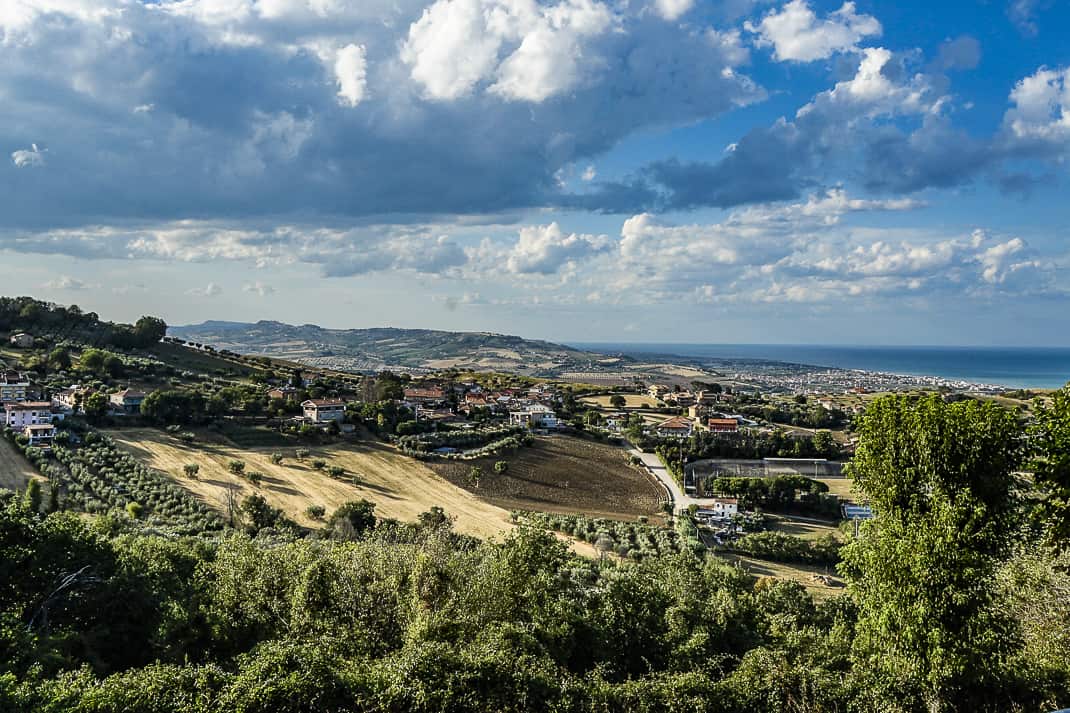
TORTORETO, Italy — I’m not religious but living in Italy I often experience heaven.
Take mass Thursday night. No, it wasn’t anything the priest said that made me feel God’s presence. It was the mass’ setting. I was in Tortoreto, a charming, medieval hill town on Abruzzo’s Adriatic coast. This town of about 11,500 was celebrating the Festa della Madonna della Neve and they moved the mass to Piazza Campo della Fiera, just below the town’s narrow main drag overlooking the Abruzzo countryside.
During down times, the piazza is a parking lot. But on this night they turned it into the centerpiece of the historical and natural beauty of Abruzzo, the most underrated region in Italy. I sat in one of the roughly 150 chairs in the piazza, staring at the white-robed priest on a makeshift stage. Above him was a 1,000-year-old brick bridge with a medieval, brick clock tower dating back to 1881 hovering above.
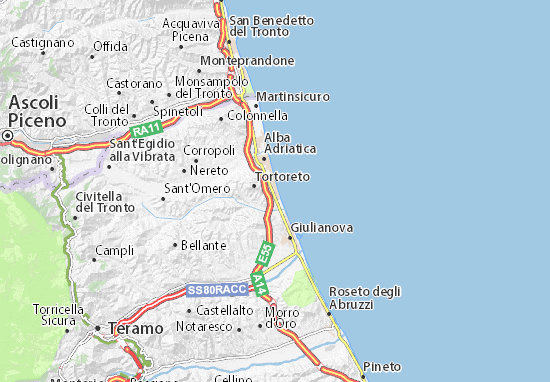
Behind me lay vineyards leading to the whitewashed roofs of Tortoreto Lido and the Adriatic Sea, still royal blue in the fading early evening light. I’ve been to many masses in Italy. It’s part of the Catholic culture that may be fading in modern Italy but dates back 2,000 years.
I have never been to another mass that took my breath away.
The priest talked to the piazza filled with casually dressed Abruzzesi about the tough year we’ve had. People are separated from loved ones. Loved ones are dying. We must appreciate what we still have.
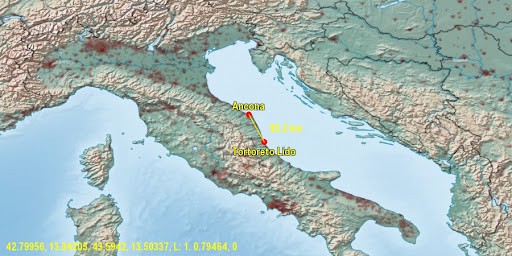
In this slice of Italy, that’s easy.
It’s one reason we came here. Italy is in what officials say is a fourth wave of Covid. It’s why on Friday they started a policy where anyone in Italy must show proof of vaccination to get into restaurants, cafes, cinemas, concerts, sports events, etc. Marina and I are both double vaccinated and feel even safer in a country that values science, even one that’s the center of the Catholic world.
So we’re traveling again.
The journey
We chose Tortoreto as the perfect combination for travel in an Italian August with the temperatures hitting the 90s in Rome. Tortoreto is off the beaten path in an Abruzzo region that’s off the beaten path in Italy. Sitting at 239 meters (785 feet), Tortoreto is a nice respite from the steaming heat in the surrounding valleys. Tortoreto Lido, its modern municipality directly below it, sits on a long, golden-sand beach on the clean, warm Adriatic Sea.

Very few Americans come to Abruzzo. It’s not on the well-worn American tourist triangle of Venice-Florence-Rome. Even fewer come to Tortoreto. It isn’t easy to reach. But Abruzzo is one of our favorite regions. It’s where you can get into the mountains quickly from Rome, eat great local cuisine like arrosticini (roast sheep on a stick), drink the famed Montepulciano d’Abruzzo red wine and meet friendly, down-to-earth and fiercely independent Abruzzesi.
“People in Abruzzo, they say we are forte e gentile (strong and nice),” said Giorgio Mincioni, owner of our hotel and a Tortoreto native. “We can look like we’re not so gentle in the first way but then people are really open minded to make the experience of people here in the best way.”
For tourists, Tortoreto is 210 kilometers (125 miles) from Rome and a hassle to reach. Even if you arrive by bus, you need a car to explore the area. Public transport here is sketchy. I rented a car at Rome Fiumicino Airport and drove us the three hours through the glorious Abruzzo countryside. Shortly after crossing the Abruzzo border to the east, the massive, craggy, brown Gran Sasso mountain range comes into view.
Slicing through a rift in the range we came into beautiful patches of farmland, of vineyards and olive trees, of villages with trees lining streets like sentries and old locals gossiping and sipping coffee in small piazzas.

Finding our hotel was a challenge, both to our GPS and tempers. Il Parco sul Mare sits atop a hill halfway up between Tortoreto Lido and Tortoreto. The GPS ended on the hill and so did the residences. It wasn’t until we turned around three times and Marina threatened my life twice before we ventured farther up the hill where we found the hotel, sitting alone like a retreat for medieval royalty.
Il Parco sul Mare is a palace. In 2009 the Mincionis bought this villa of a wealthy Abruzzese and turned it into a four-star resort and spa. Our spacious second-floor room had a big balcony overlooking the glistening swimming pool with the Terraviva winery and its vineyards next door. On our walk to the pool the calm, inviting Adriatic beckoned us. The beach was a 10-minute drive away.
A mini fridge. A big buffet breakfast with cheeses and meats and cornettos and handmade cakes and local fruits. An indoor Jacuzzi. Easy parking. Turns out, for one of the few times in my life, I was taking a priest’s advice.
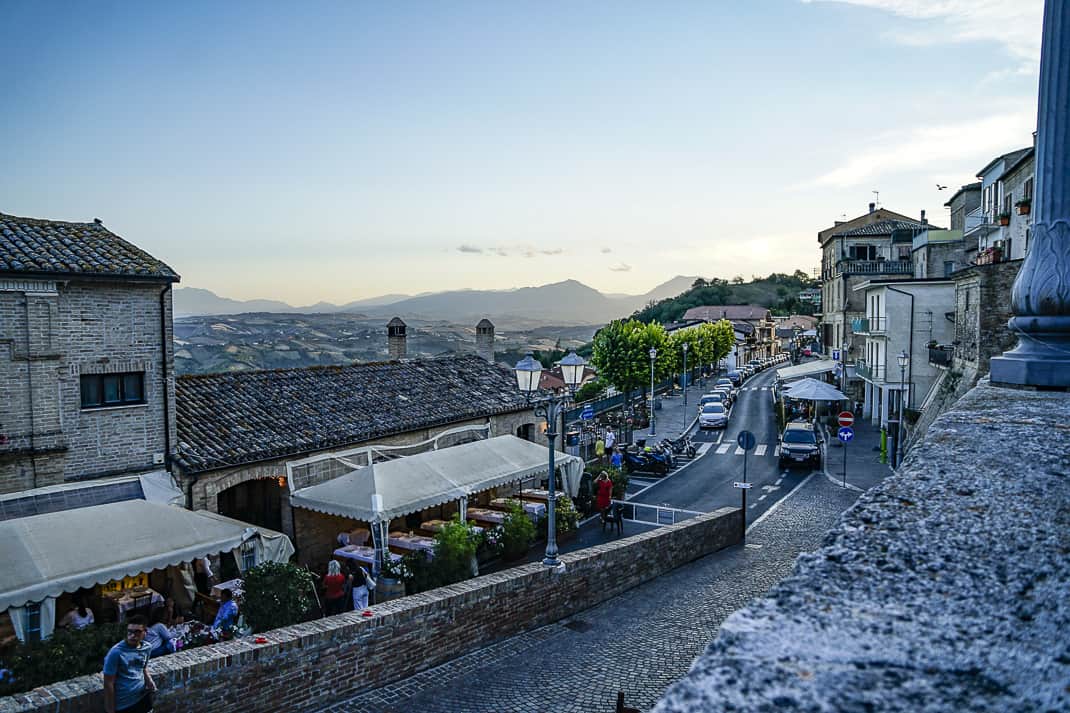
Tortoreto Alto
The old town of Tortoreto is about a 10-minute uphill drive — or a moderately challenging 30-minute hike as Marina discovered one morning. It’s naturally called Tortoreto Alto (High Tortoreto). I’d park along the long, two-lane stone road lined with tiglio trees with their round, leafy bloom that makes them look like giant green gumballs. Looking down from the wall we saw the patchwork farmland to our left and the towering Grand Mastif, at 2,500 meters (8,200 feet) the highest mountain in central Italy, to our right. A welcome cool breeze drifted down from the mountains.
We were three hours from Rome but seemingly three continents away in atmosphere.
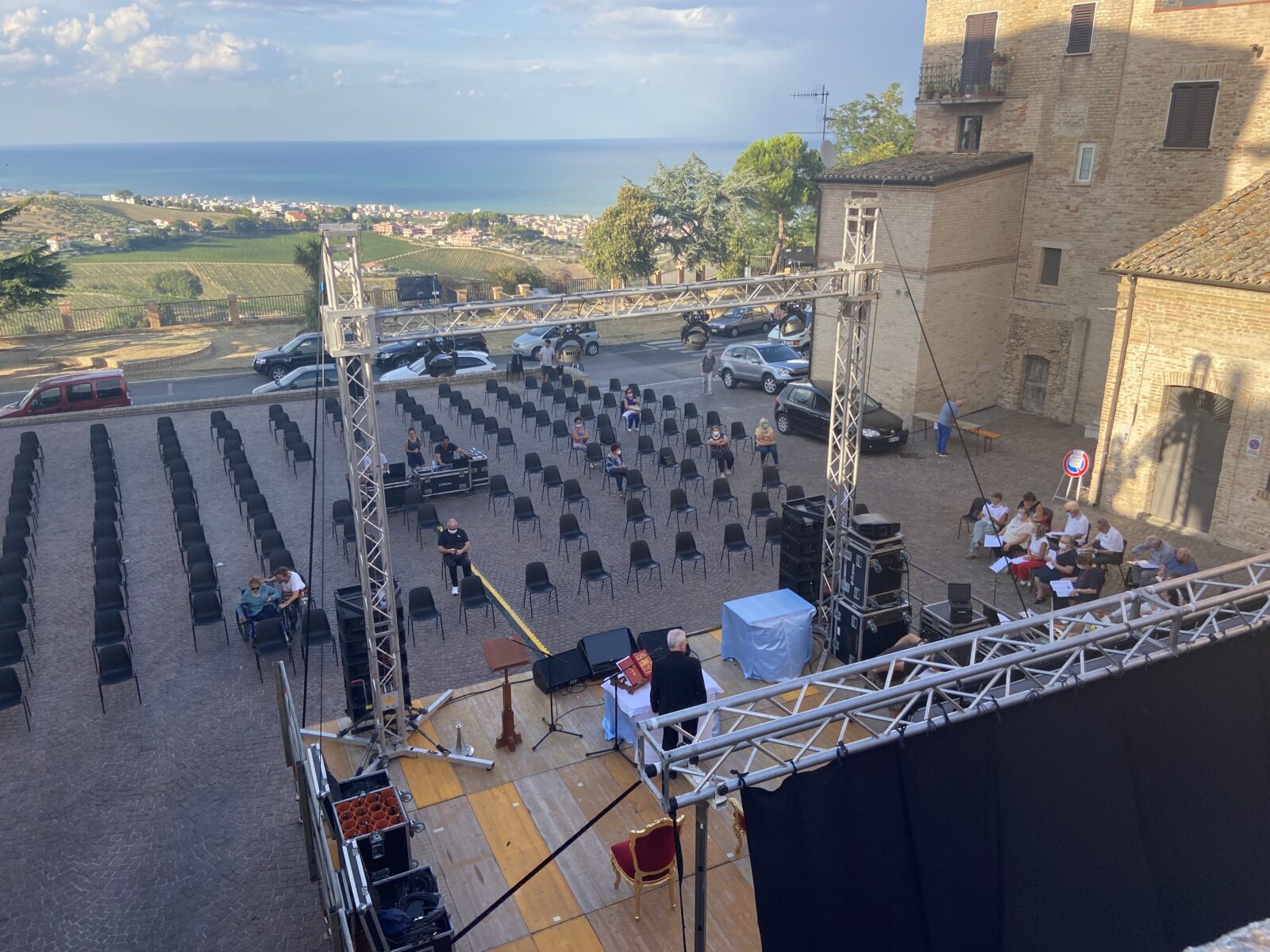
We took a seat at the Panorama Caffe and drank Trebbiano and Spritz as Italian pop tunes played for locals just getting off work.
Our green pass, Italy’s vaccination passport, seemed worthless here. You don’t need it to dine outside in Italy and who wants to sit inside with God’s country all around you? We walked a few meters to one of the long string of restaurants with panoramic views. I Compari del Barone (The Friends of Rich Men) has outdoor tables outside its building that dates back to the 7th century. It once served as a gathering place for the partigiani resistance during World War II.

Today it specializes in arrosticini, Abruzzo’s signature sheep on wooden skewers in which you can order as many as you want, both medium and small sizes. They come in a clay pot and you tear the meat off with your teeth like barbarians in a medieval court. It’s quite liberating and looking down at the beautiful countryside, you almost think Prince Arthur on horseback will come storming up the road.
I also ordered formaggio fritto, these fried cheese patties that combine cow and sheep cheese and really isn’t as filling as it reads. The waitress gave me a house shot of Acquasanta, their local orange liqueur they light on fire before serving. At 40 proof, it was the perfect end to our evenings as I flipped my car keys to teetotaling Marina.

Tortoreto Lido
Beaches in Italy in August can be problematic. In this period of Covid, they can be dangerous. Despite Italy’s tourist industry still recovering from its slumber, the beaches along Italy’s 1,249-kilometer (750-mile) Adriatic coast are crowded. Our hotel reservation guaranteed us a spot on one section of Tortoreto Lido for 10 euros each and I could quickly tell the current theme is “Covid be damned.”
The beach’s desk clerk looked at a seating chart of about 400 lounge chairs. He searched to find two free. He did and we meandered through the sand looking for our chairs with the corresponding numbers like lockers in a fitness club. Yes, lounge chairs covering nearly every speck of sand thoroughly spoil the beauty of natural beaches.
It’s the Italian’s equivalent of putting pineapple on pizza.
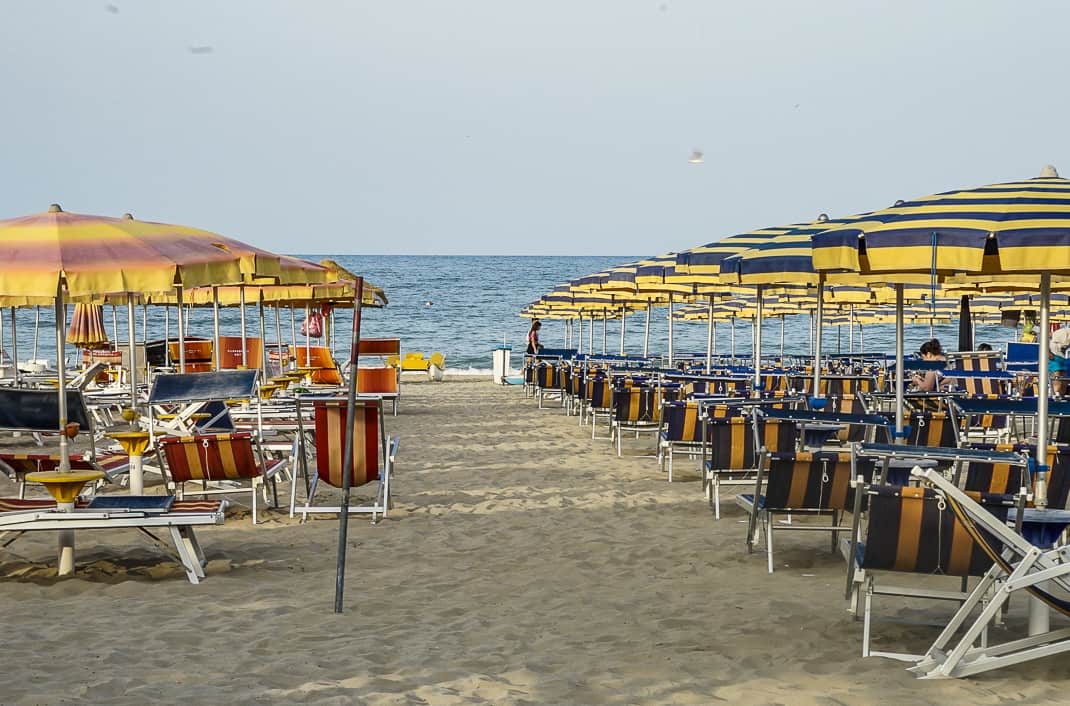
But it’s common all through Southern Europe and we’re used to it. Besides, it’s easier to read good books on a beach when you have a seat back and a handy, maneuverable face covering connected to the chair.
The Adriatic beach isn’t beautiful but very functional. The golden sand is completely void of stones. So is the sea which at Tortoreto Lido is as calm as a bathtub and goes out about 100 meters before it’s over your head. In August, the water temperature is a balmy 80 degrees.
Tortoreto Lido’s 3-kilometer-long beach wasn’t cheek to cheek (and with some of the aging bodies there the cheeks took up more than their share of space.) But we left the beach early afternoon and strolled Tortoreto’s historic boardwalk.

The history
Until the 1960s, Tortoreto Lido’s main industry was fishing. But entrepreneurs saw the sparkling sand and clear ocean and hotels began popping up. The area grew steadily until the 2000s when everything exploded.
The growth coincided with a regional plan in 1998 to build a bike path. Today, about 85 percent is done of a two-lane, paved, marked bike path that goes from Martinsicuro on the northern border with Le Marche to Vasto, on the southern border with Puglia, a stretch of 135 kilometers (80 miles).
We walked along the path, called Bike to Coast, dodging cyclists, joggers, lovers and skateboarders. Here is where the beauty from the beach salutes visitors. On the four kilometers (2.5 miles) of bike path in Tortoreto Lido and the four in neighboring Alba Adriatica are more than 1,000 palm trees.
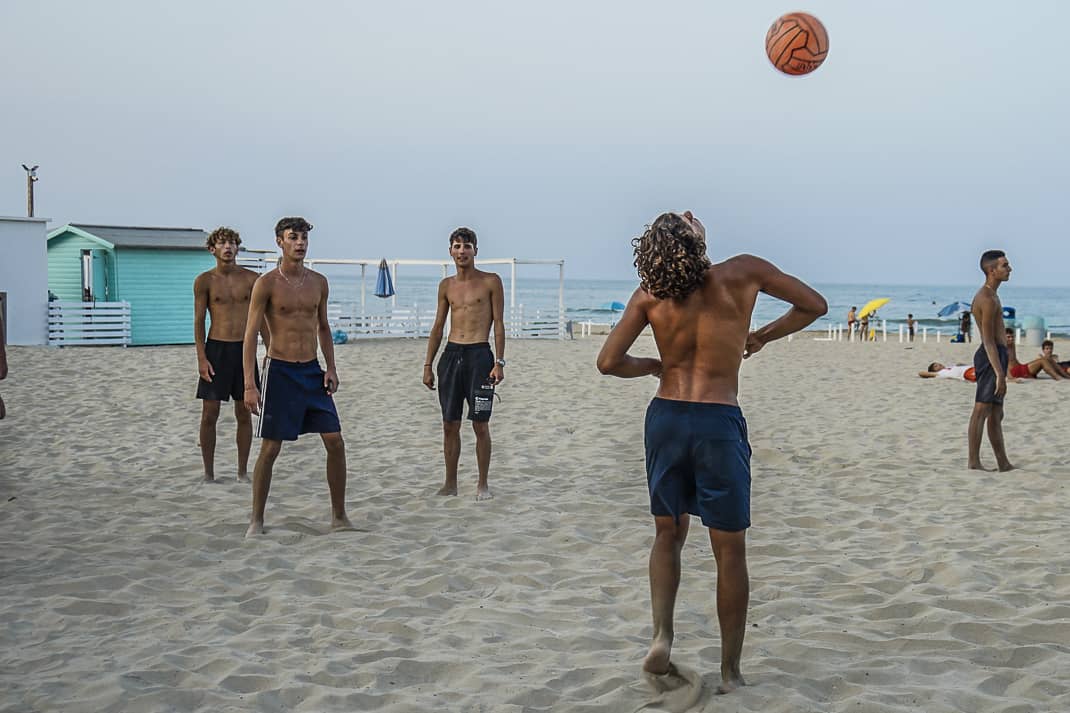
It’s called the Riviera delle Palme and it gives the place a South Florida or Caribbean feel. Then we smelled pizza filling the air and heard wine glasses clinking in the bars and we were quickly brought back to our true planet.
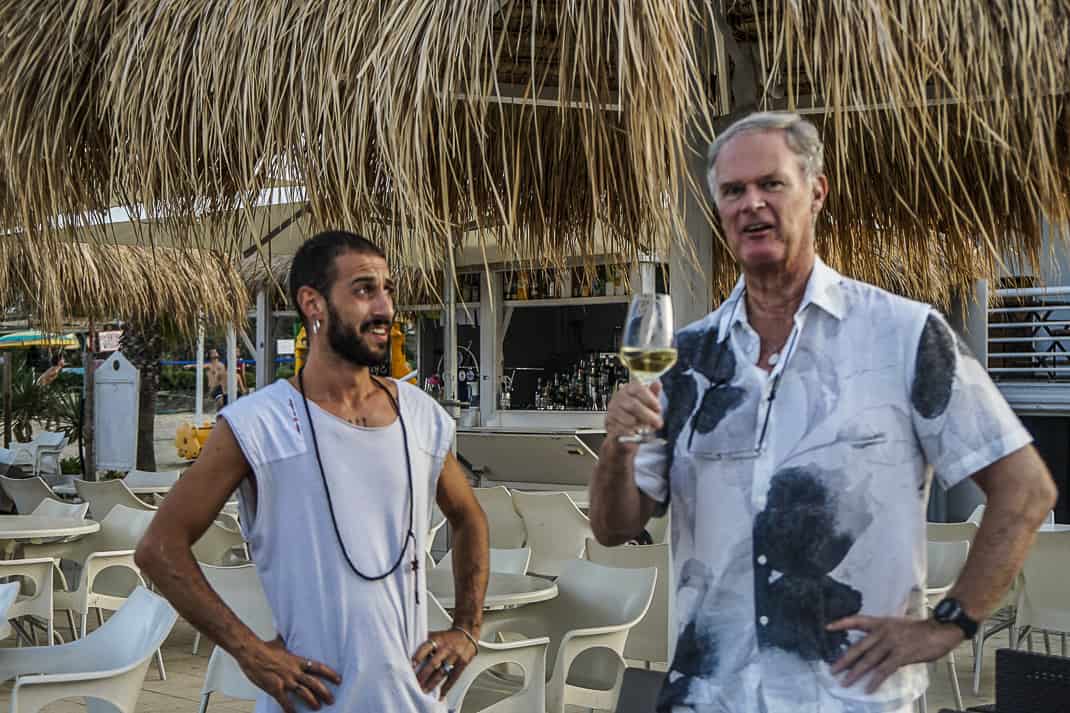
On a warm early evening, we stopped at one of a long string of beach bars. At Funky Beach, we sat in padded chairs looking out at the sea and drank long, cool Spritzesand equally chilled Trebbiano. Tiziano, a friendly 27-year-old waiter with big earrings, beard and hip air, said the tourists are coming back but “You’re the first American I’ve ever met here.”
I took it as a compliment. I took it as confirmation of Abruzzo’s appeal, Covid and all.
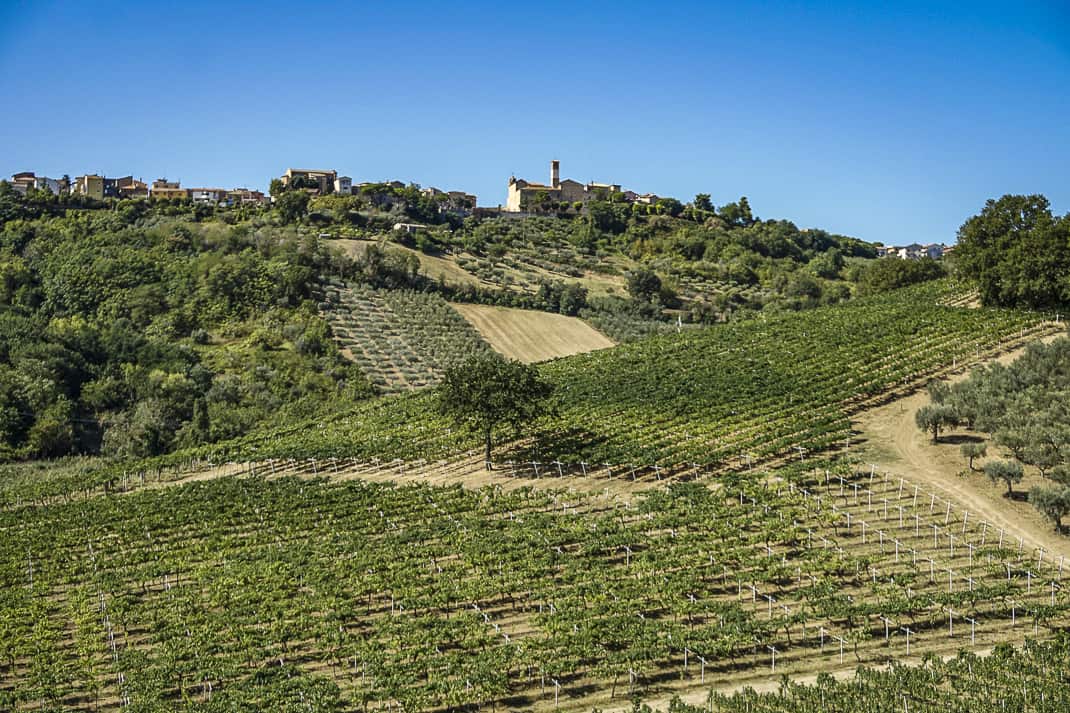
Terraviva
I’ve had wine in some very picturesque settings at Italian wineries. One overlooked vineyards stretching to the horizon in Tuscany. Another in Lazio looked down at the city of Rome. But never have I seen a vista such as the one next door to our hotel.
Terravia sits on 30 hectares (74 acres) of land with 21 (52 acres) of them vines of their own indigenous grapes. They stretch up a hill creeping to Tortoreto Alto with the clock tower sticking up like a lighthouse for lost wine lovers. To the right is Tortoreto Lido and the blue Adriatic.
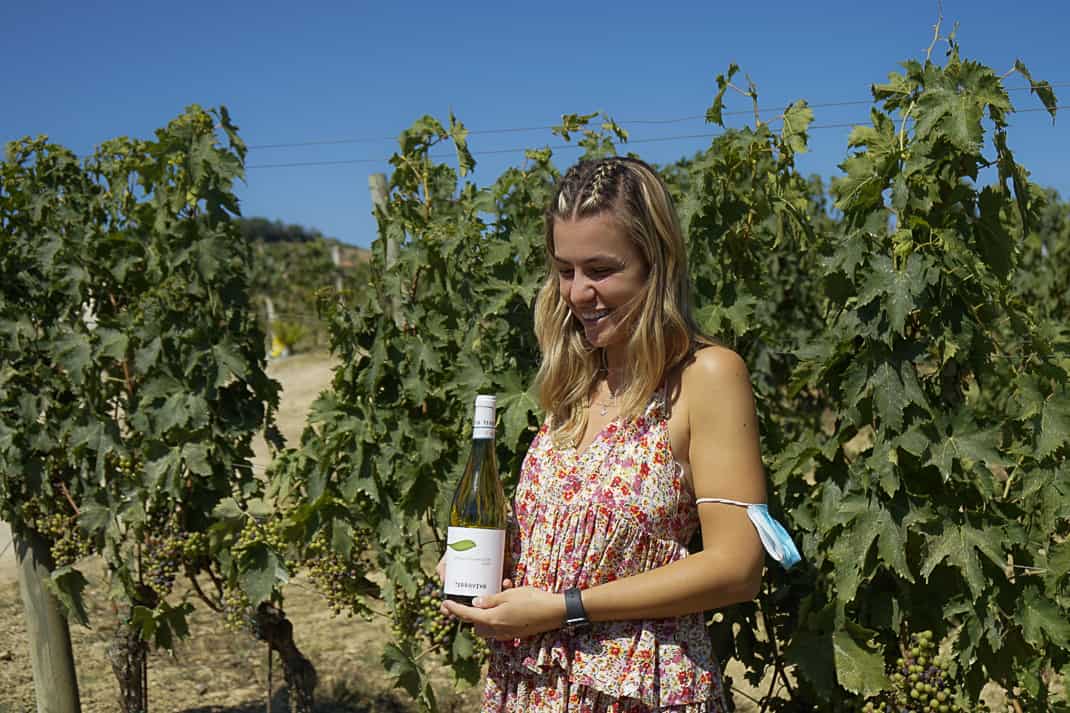
It’s why Terravia calls the products “seaview wines.”
I got thirsty just approaching the front door. It was 10 a.m.
Federica Topi is a Tortoreto native whose grandfather bought the surrounding land and opened the winery in 1970 and certified it organic in 1998. It grows Abruzzo’s signature Pecorino, Trebbiano and Passerina wine grapes as well as the famous Montepulciano red.
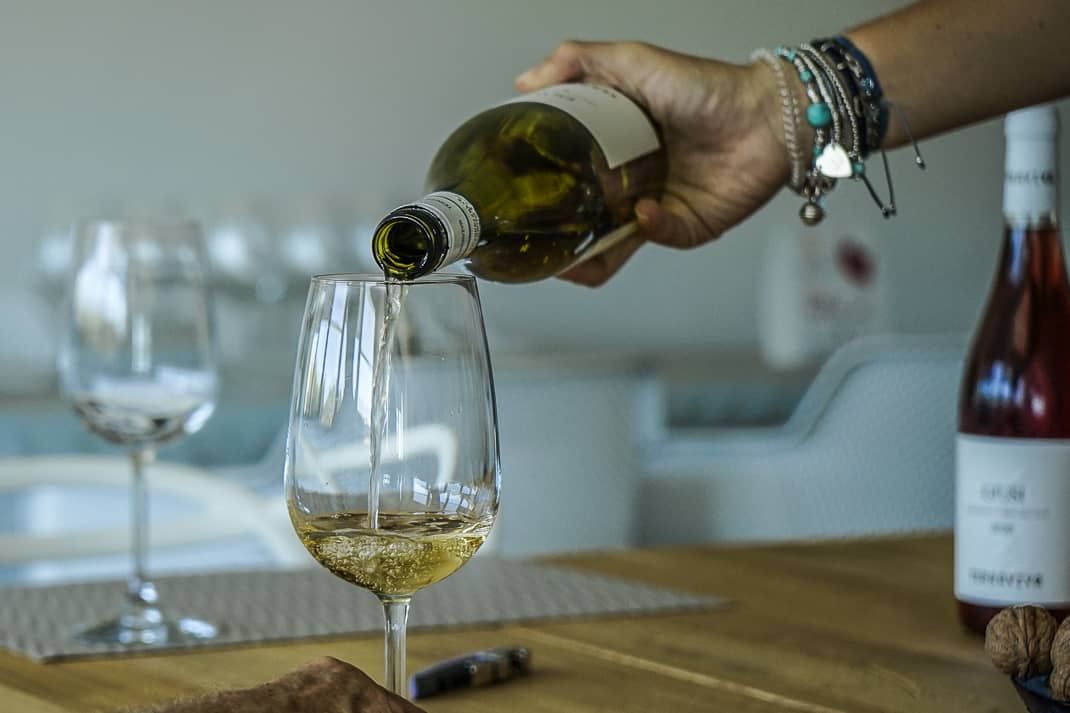
However, they sold their grapes to coops who distributed them around the country for production. Wanting their own signature wines and to cut the expenses selling to coops, she and her father Pietro started making their own wines in 2008 working only with Abruzzo indigenous grapes with the idea to represent the territory where they’re coming from.
“We love this place,” she said. “We love the contact with nature. We decided to start this new adventure. It’s really, really interesting because every day is different than the other one.”
Montepulciano and Trebbiano have inched into my top echelon of my favorite Italian wines. Order a house wine anywhere in Rome and likely you’ll get Montepulciano. It’s an easy grape to grow yet is consistently good. It’s not like house wine in the U.S. where the Merlot is bottom-of-the-barrel grapes that will give you a hangover before you return to your car.

Like many Italian wineries, Terravia doesn’t use many sulphites, the ingredient that preserves wine but also causes headaches. They use only 40 milligrams for reds and fewer than 50 for whites. The U.S. allows up to 350.
Business is good. They produce about 80,000 bottles a year — 50 percent Montepulciano and 50 percent whites — and export all over the world, from North America to Brazil to Australia and Japan as well as Northern Europe.
She gave me a tasting of five wines. The best was a Montepulciano from 2018 — “a very good vintage,” Federica said — and it was. Very easy to drink and it goes with everything.

I also loved the Trebbiano 2020, a crisp, fruity wine that is perfect for Italian Augusts with an aperitivo at a table overlooking the sea.
The best part about Terraviva wines? Most of them retail for 10-15 euros and I bought the two above for my wine rack at home. The Trebbiano was emptied by the next night.
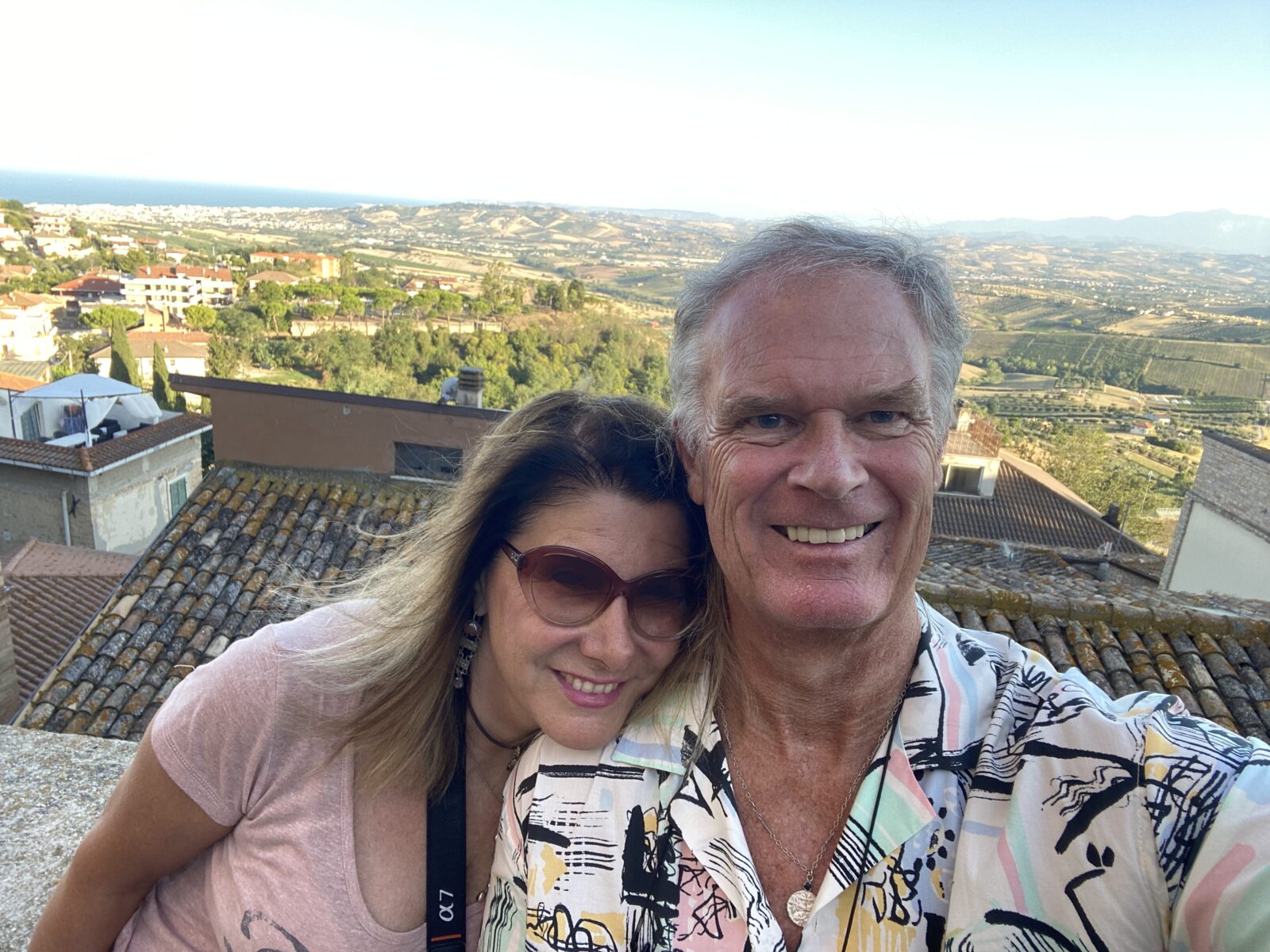
The countryside
You need a car in Tortoreto for more than just Tortoreto. The Abruzzese countryside is sprinkled with cute, untouched villages waiting to be explored. We spent one afternoon driving 8 kilometers (5 miles) to Corropoli, a town of about 4,000 in the foothills.
The best part about the Italian countryside is the Italian food reaches a different level. It’s as authentic as you can get. No English menus. No packaged pasta. No tourist prices. We stopped at an agriturismo called Il Grillo. An agriturismo is a farmhouse that also serves as a restaurant and occasional hotel.
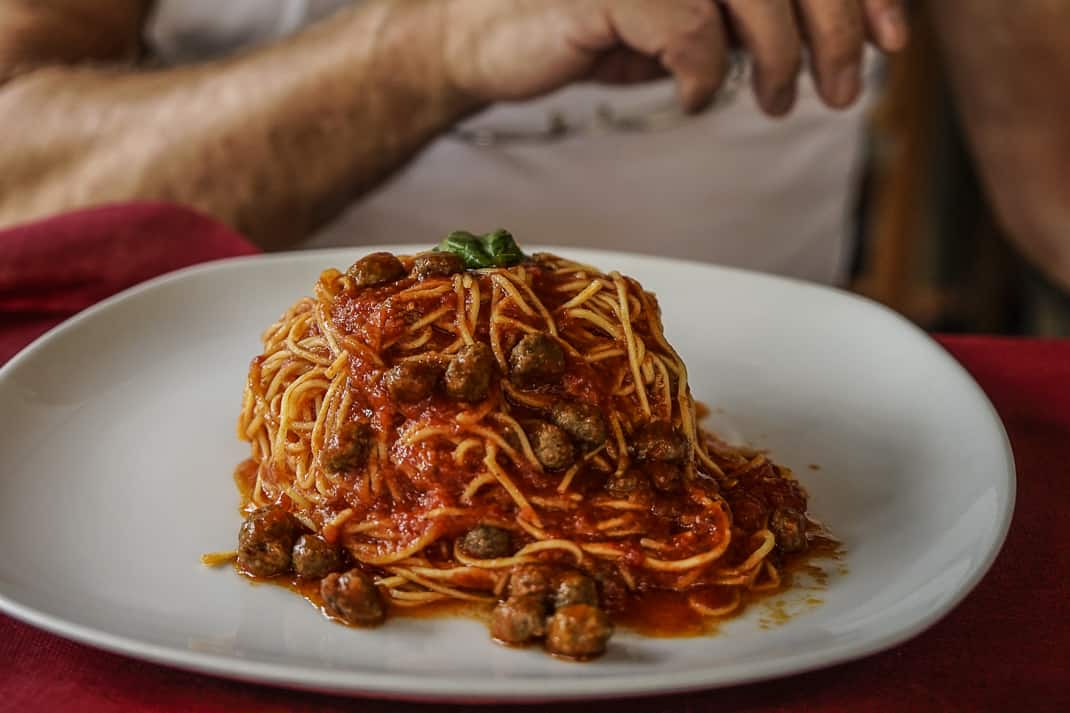

Il Grillo is a modest two-story house surrounded by olive trees and a small sign out front. Boys played soccer around the corner from 10 tables on a stone floor. We sat under a cloth canopy next to locals eating lunch and speaking in an Abruzzese dialect that Marina couldn’t even understand.
We ordered olive ripiene, olives stuffed with meat, breaded and deep fried. We had 10 for 4 euros. I had the chitarra all’Abruzzese, razor thin, long pasta with round chunks of beef in a tomato sauce topped with a big basil leaf. That was 6 euros. For the olive antipasto, two main dishes and a half liter of wine, I paid all of 21 euros.
Marina didn’t threaten my life on this drive.
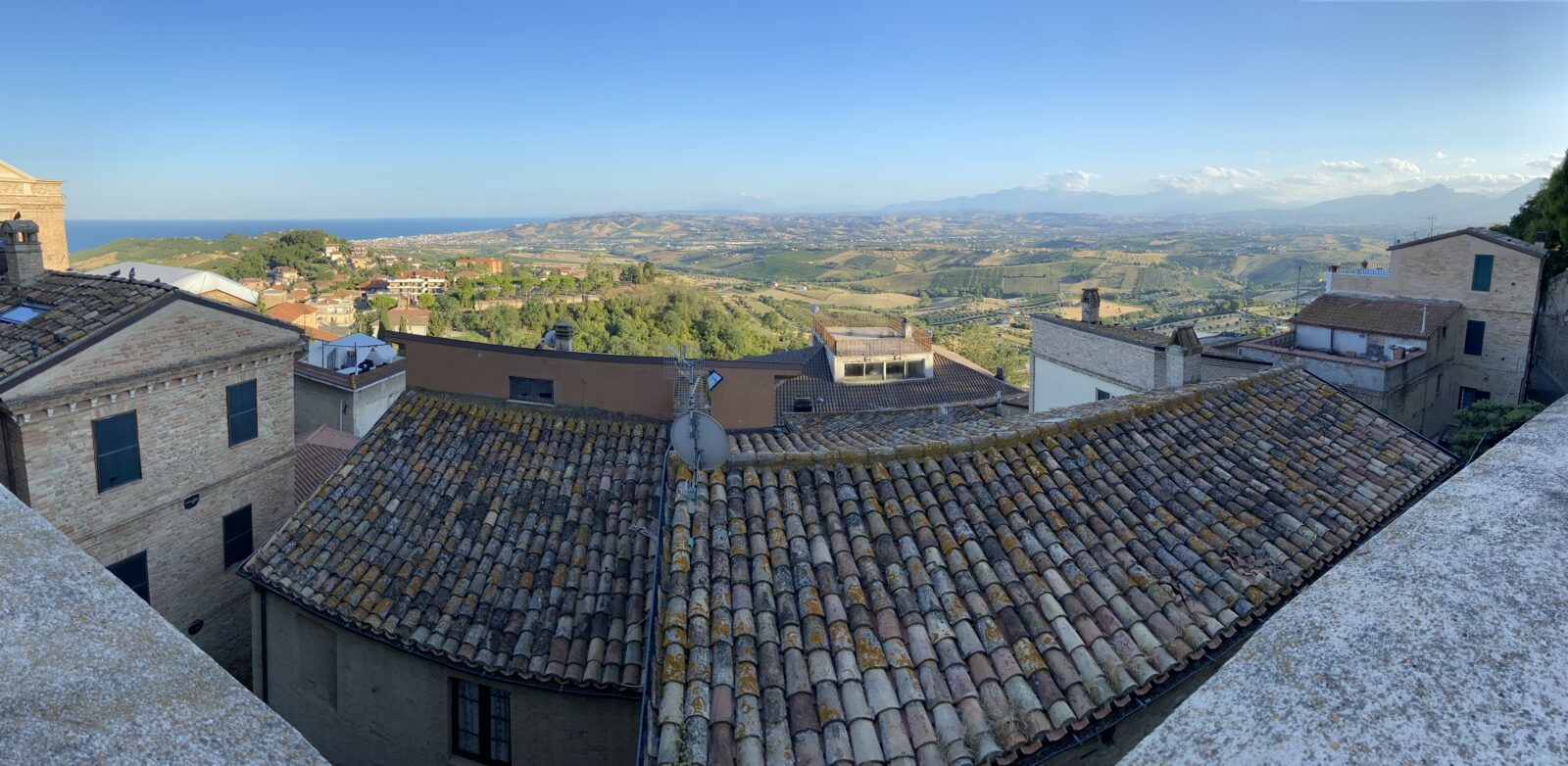
The next day we went to Colonnella, 12 kilometers (7 miles) north right near the Marche border. We climbed high into a hill town of 3,500 people at 300 meters (994 feet) elevation. Steep, narrow staircases took us to viewpoints of spectacular vistas. In the distance we could see the Abruzzo countryside below us, the Marche countryside to our left and the blue Adriatic framing it all.
We walked a short way to the other side of the village and we stared at the majesty of the Gran Sasso. A cool breeze came down from the mountains.
We didn’t want to leave, Colonnella or Abruzzo. But August in Italy is holiday season when seemingly everyone in Italy is on vacation. We beat the crowds coming from the other direction as we heard on the radio of traffic warnings all around the country.
We returned on a Saturday. I didn’t attend a mass the next day. I already had my religious experience.
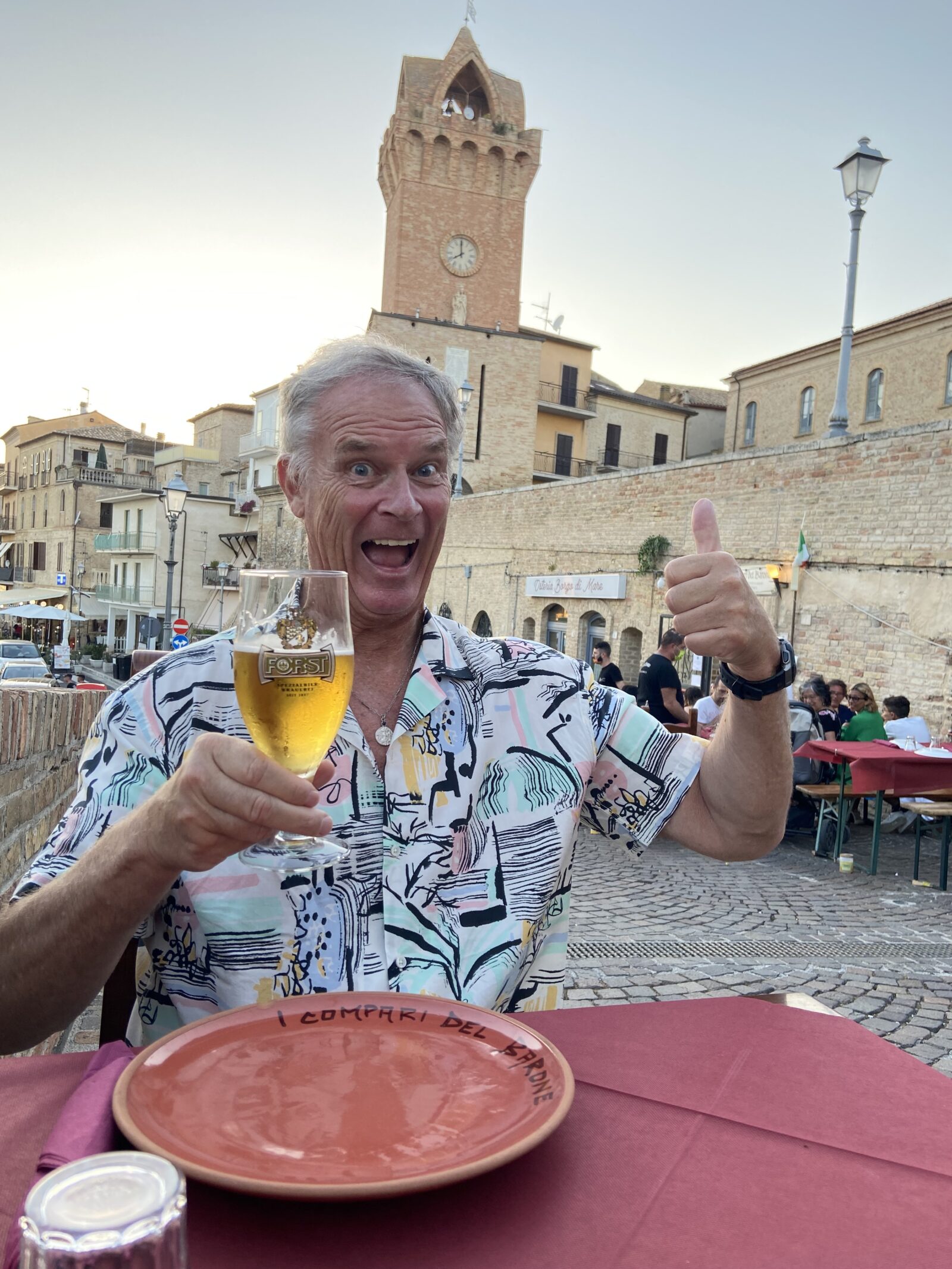
If you want to go …
How to get there: About five buses leave daily from Rome’s Tiburtina station to Tortoreto. The 4-hour, 15-minute ride is 7-11 euros. A five-hour train changes at Pescara and is 19-40 euros. The best option is by car. I rented one at Fiumicino Airport for 346.72 euros ($410) for five days including full insurance.
Where to stay: Il Parco sul Mare, Via Vascello 17/A, Tortoreto, 39-08-617-77325, www.ilparcosulmare.com, info@ilparcosulmare.com. A standard double room in August is 125 euros, September 75 euros, October and June 69 euros. Spa and Jacuzzi extra. Half board available. Free shuttle to beach for stays of at least three nights.
Where to eat: I Compari del Barone, Via Terranova 7, Tortoreto Alto, 39-08-617-88786, 39-327-710-4440. 7:30 p.m.-midnight. Traditional Abruzzese cuisine at very affordable prices.
Vivere di Mare, Lungomare Sirena 430, Tortoreto Lido, 39-08-61-781-009, 39-329-664-0146, www.viveredimare.it. 11 a.m.-midnight Thursday-Sunday, 6 p.m.-midnight Tuesday-Wednesday. Fresh local seafood from 8-17 euros.
Where to drink: Terraviva, Via del Lago 19, Tortoreto, 39-08-617-86056, www.tenutaterraviva.it, info@tenutaterraviva.it. Wine tastings available at winery next door to Il Parco sul Mare from 9-noon and 2:30-6 p.m. Monday-Friday. Starter Tasting (three wines) 15 euros, Old Vines Tasting (5 wines) 30 euros, Terraviva Experience Tasting (2 Terraviva wines and 5 old vines line) 40 euros. Reservations required.
Monday-Friday from 9.00 – 12.00 and 2.30-6PM
For more information: Abruzzo Department of Economic and Tourism Development, Via Passolanciano 75, Pescara. Redazioneweb@abruzzoturismo.it. 9:15 a.m.-1:15 p.m. Monday-Friday, 9:15 a.m.-1:15 p.m., 3:15-5:15 p.m. Tuesday-Thursday.


August 10, 2021 @ 9:37 am
That just looks amazing John! Thank you for sharing! Any place that doesn’t see Americans is tops on my list!!
August 10, 2021 @ 10:43 am
Agreed. Abruzzo is an amazing place. Sea, mountains, history, food, vistas, wine, narkets, friendly people. The lack of bus loads of tourists is a major plus. We have been there several times but not enough.
August 10, 2021 @ 4:36 pm
Excellent article and so inspiring to read of your travels whilst we’re in lockdown 6 here in Melbourne.
Thank you
Joanna
August 10, 2021 @ 5:19 pm
Yes very nice and all, but roads are outrageously bad in that area. Holes everywhere. A little distraction can easily damage your car
August 10, 2021 @ 10:28 pm
What an informative piece of journalism- enjoy your perspective and thoroughness… thanks so much, living vicariously, Angela